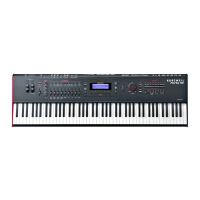Multi Edit Mode
MAIN Page
7-10
Oset and Scale work together. If scaling takes the velocity out of the ballpark — for
example, you want to set it to 300% but that puts all of your notes at maximum velocity —
using a negative oset, say around -60, can make it possible to still play at dierent volumes,
although your curve will still be a lot steeper than normal. If you use a negative scaling,
then you must use an oset: otherwise all of your velocities will end up as zeroes (well, ones
actually, since a MIDI note-on with velocity zero is interpreted by some modules as a note-
o message). So to get true inverse scaling (that is, minus 100%), you must set an oset of
127 to get the full range of velocities. Setting the oset to 127 and the scale to -100% (which
is the same as the reverse linear curve).
Note: Oset and Scale only aect incoming MIDI velocities; these parameters don’t change
Velocity Tracking in the programs themselves. erefore, programs which have low VelTrk
values may respond only subtly to Oset and Scale, or not at all.
Velocity Curve
e Velocity Curve parameter lets you taper the velocity response. e default setting is
Linear, which means that the output velocity changes directly proportionally to the played
velocity.
Expand produces a curve that is less steep than the linear curve at keystrike velocities below
64, and steeper than the linear curve at keystrike velocities above 64. In other words, when
you’re playing softly, you’ll notice velocity dierences less than with a linear curve, while
when you’re playing hard, you’ll notice velocity dierences more.
Compress produces a velocity curve that is the opposite of the expanded curve—that is,
you’ll notice velocity dierences more when you’re playing softly than when you’re playing
hard.
Crossfade is designed to be used in tandem with the Reverse Crossfade curve, enabling you
to perform smooth crossfades between dierent programs.
Bump tapers velocity response to resemble a bell curve, so that notes are loudest when your
keystrike velocity is 64. Notes get softer as the keystrike velocity approaches 0 or 127.
e next four velocity curves are Reverse Linear (Rvrs Linear), Reverse Expand (Rvrs
Expand), Reverse Compress (Rvrs Compress), and Reverse Crossfade (Rvrs Crossfade).
ese taper velocity in reverse of the ve curves we just covered. For example, Reverse
Linear’s response is such that striking a key harder will produce a lower volume, striking it
softer will produce a higher volume, and so on. is provides a convenient way to achieve
negative scaling, by letting you set one parameter instead of two.
Low Velocity, High Velocity
Low Velocity and High Velocity set the minimum and maximum velocity limits that the
current Zone transmits.

